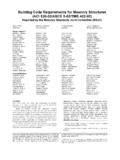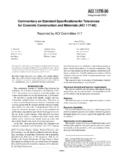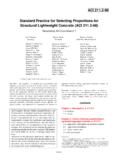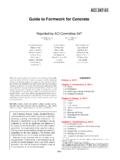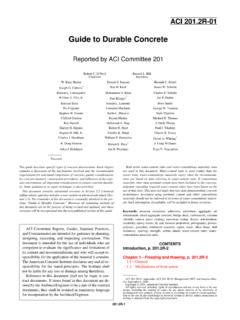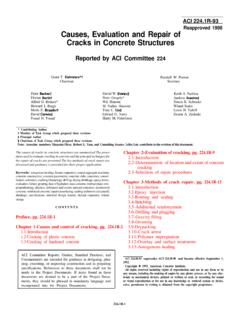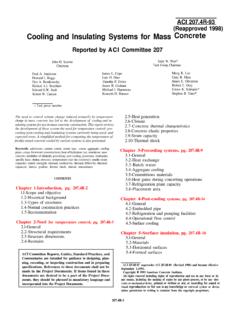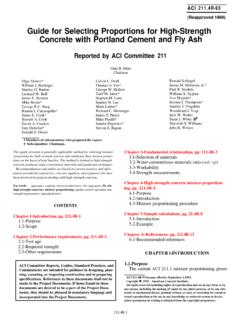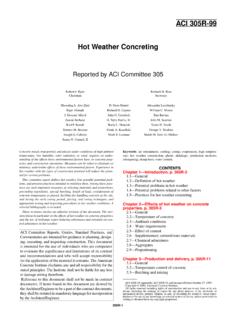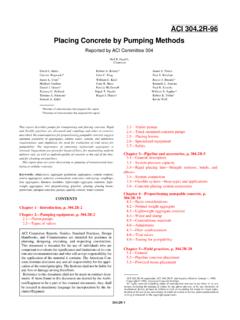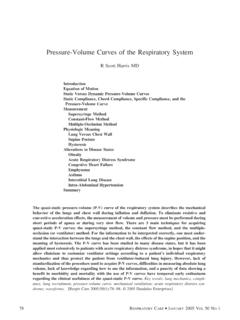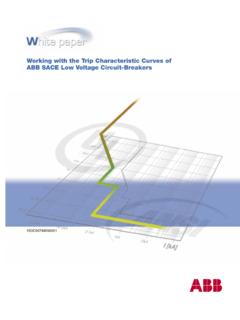Transcription of 207.2R-95 Effect of Restraint, Volume Change, and ...
1 Report presents a discussion of the effects of heat generation and vol-ume change on the design and behavior of reinforced mass concrete ele-ments and structures. Particular emphasis is placed on the effects ofrestraint on cracking and the effects of controlled placing temperatures,concrete strength requirements, and type and fineness of cement on volumechange. Formulas are presented for determining the amounts of reinforcingsteel needed to control the size and spacing of cracks to specified limitsunder varying conditions of restraint and Volume : adiabatic conditions; age; cement types; concrete dams; con-crete slabs; cooling; cracking (fracturing); crack propagation; crack widthand spacing; creep properties; drying shrinkage; foundations; heat ofhydration; heat transfer; machine bases; mass concrete; modulus of elas-ticity; moisture content; placing; portland cement physical properties; port-land cements; pozzolans; reinforced concrete; reinforcing steels; restraints ; shrinkage; stresses; structural design; temperature.
2 Temperaturerise (in concrete); tensile strength; thermal expansion; Volume change ;walls. CONTENTSC hapter 1 Introduction, p. Approaches to control of crackingChapter 2 Volume change , p. Heat Moisture contents and drying Ambient, placement, and minimum service Placement Minimum temperature in Heat dissipation and coolingACI supersedes ACI and became effective January 1, 2002, American Concrete 1995 revisions consisted of many minor editorial and typographical correctionsthroughout, as well as some additional explanatory information. All rights reserved including rights of reproduction and use in any form or by anymeans, including the making of copies by any photo process, or by any electronic ormechanical device, printed, written, or oral, or recording for sound or visual reproduc-tion or for use in any knowledge or retrieval system device, unless permission in writ-ing is obtained from the copyright of Restraint, Volume change , and Reinforcement on Cracking of Mass ConcreteReported by ACI Committee 207 Members of the committee voting on proposed revisions: James L.
3 Cope ChairmanRobert W. Cannon*Vice ChairmanEdward A. Abdun-NurLuis H. DiazRobert F. OuryFred A. AndersonTimothy P. DolenJerome M. Raphael Howard L. BoggsKenneth D. HansenErnest K. SchraderDan A. BonikowskyGary R. Mass*Stephen B. Tatro*Richard A. Bradshaw, T. McCarthyTerry L. WestEdward G. W. Bush James E. Oliverson*Members of the task group who prepared this report. Chairman of the task group who prepared the report. Deceased. John M. Scanlon ChairmanHoward L. BoggsLuis H. DiazGary R. MassDan A. BonikowskyTimothy P. DolenRobert F. OuryRichard A. Bradshaw, I. HammonsErnest K. SchraderRobert W. CannonKenneth D. HansenGlenn S. TarboxAhmed F. ChraibiAllen J. HulshizerStephen B. TatroJames L.
4 CopeMeng K. Lee*Terry L. West*Chairman, Task Committee Reports, Guides, Standard Practices, and Com-mentaries are intended for guidance in designing, planning, ex-ecuting, or inspecting construction and in preparingspecifications. Reference to these documents shall not be madein the Project Documents. If items found in these documents aredesired to be part of the Project Documents, they should bephrased in mandatory language and incorporated in the COMMITTEE Summary and examplesChapter 3 Properties, p. General Strength Tensile Modulus of Thermal properties of concreteChapter 4 Restraint, p. General Continuous external Discontinuous external or end Internal restraintChapter 5 Crack widths, p.
5 General CalculationsChapter 6 Application, p. General Volume change plus Volume change without Recommendation for minimum Design procedureChapter 7 References, p. Recommended references Cited Additional referencesAppendix, p. conversionsCHAPTER 1 ScopeThis report is primarily concerned with limiting the widthof cracks in structural members that occur principally fromrestraint of thermal contraction. A detailed discussion of theeffects of heat generation and Volume changes on the designand behavior of mass reinforced concrete elements andstructures is presented. It is written primarily to provideguidance for the selection of concrete materials, mix require-ments, reinforcement requirements, and construction proce-dures necessary to control the size and spacing of emphasis is placed on the Effect of restraint to vol-ume change in both preventing and causing cracking and theneed for controlling peak concrete temperature.
6 The qualityof concrete for resistance to weathering is not emphasized inrecommending reduced cements contents; however, itshould be understood that the concrete should be sufficientlydurable to resist expected service conditions. The report canbe applied to any concrete structure with a potential for un-acceptable cracking; however, its general application is tomassive concrete members 18 in. or more in Definition Mass concrete is defined in ACI 116R as: Any volumeof concrete with dimensions large enough to require thatmeasures be taken to cope with the generation of heat and at-tendant Volume change to minimize cracking. Reinforcedmass concrete in this report refers to concrete in which rein-forcement is utilized to limit crack widths that may be causedby external forces or by Volume change due to thermalchanges, autogenous changes and drying Approaches to control of crackingAll concrete elements and structures are subject to volumechange in varying degrees, dependent upon the makeup, con-figuration, and environment of the concrete.
7 Uniform vol-ume change will not produce cracking if the element orstructure is relatively free to change Volume in all is rarely the case for massive concrete members sincesize alone usually causes nonuniform change and there is of-ten sufficient restraint either internally or externally to pro-duce measures used to control cracking depend to a largeextent on the economics of the situation and the seriousnessof cracking if not controlled. Cracks are objectionable wheretheir size and spacing compromise the appearance, service-ability, function, or strength of the cracks should be controlled to the minimum practi-cable width in all structures, the economics of achieving thisgoal must be considered. The change in Volume can be min-imized by such measures as reducing cement content, replac-ing part of the cement with pozzolans, precooling,postcooling, insulating to control the rate of heat absorbed orlost, and by other temperature control measures outlined inACI and ACI Restraint is modified by jointsintended to handle contraction or expansion and also by therate at which Volume change takes place.
8 Construction jointsmay also be used to reduce the number of uncontrolledcracks that may otherwise be expected. By appropriate con-sideration of the preceding measures, it is usually possible tocontrol cracking or at least to minimize the crack widths. Thesubject of crack control in mass concrete is also discussed inChapter 7 of ACI 224R and in Reference 1. The topic ofevaluation and repair of cracks in concrete is covered in de-tail in ACI the design of reinforced concrete structures, cracking ispresumed in the proportioning of reinforcement. For this rea-son, the designer does not normally distinguish between ten-sion cracks due to Volume change and those due to of employing many of the previously recommendedmeasures to control Volume change , the designer maychoose to add sufficient reinforcement to distribute thecracking so that one large crack is replaced by many smallercracks of acceptably small widths.
9 The selection of the nec-essary amount and spacing of reinforcement to accomplishthis depends on the extent of the Volume change to be expect-ed, the spacing or number of cracks which would occur with-out the reinforcement, and the ability of reinforcement todistribute OF MASSIVE degree to which the designer will either reduce vol-ume changes or use reinforcement for control of cracks in agiven structure depends largely on the massiveness of thestructure itself and on the magnitude of forces restrainingvolume change . No clear-cut line can be drawn to establishthe extent to which measures should be taken to control thechange in Volume . Design strength requirements, placing re-strictions, and the environment itself are sometimes so se-vere that it is impractical to prevent cracking by measures tominimize Volume change .
10 On the other hand, the designernormally has a wide range of choices when selecting designstrengths and structural many cases, the cost of increased structural dimensionsrequired by the selection of lower strength concrete (withinthe limits of durability requirements) is more than repaid bythe savings in reinforcing steel, reduced placing costs, andthe savings in material cost of the concrete itself (see , Example ).CHAPTER 2 Volume CHANGEThe thermal behavior of mass concrete has been thorough-ly discussed in Chapter 5 of ACI This chapter's pur-pose is to offer some practical guidance in the magnitude ofvolume change that can be expected in reinforced concretestructures or elements. Such structures utilize cements withhigher heat generation, smaller aggregate, more water, andless temperature control than normally used or recommend-ed for mass concrete in reinforced concrete elements, the primary concern iswith these Volume changes resulting from thermal and mois-ture changes.
